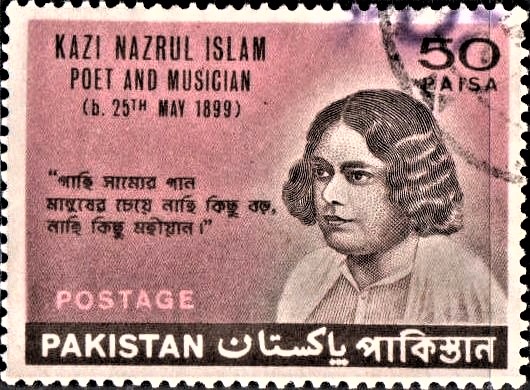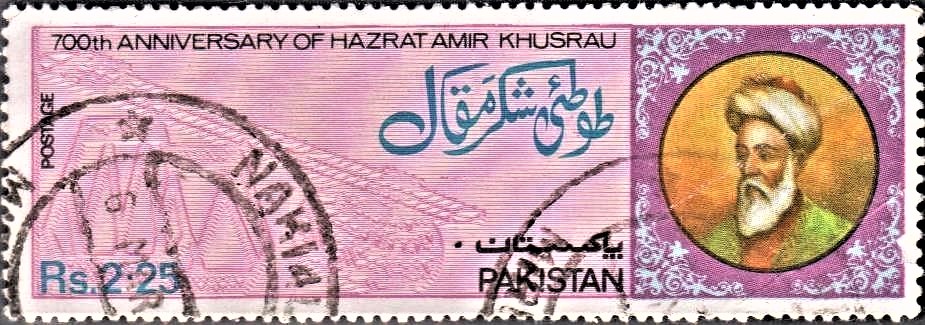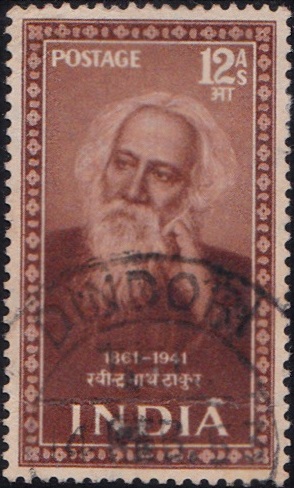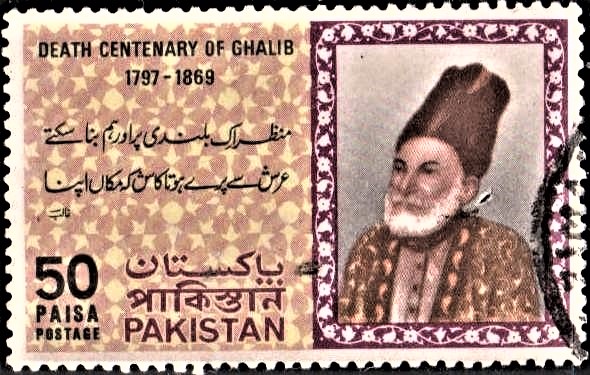
Pakistan on Ghalib 1969
Complete set of 2 nos. of commemorative postage stamp on the Death Centenary of Mirza Ghalib, a prominent Urdu-Persian poet during Mughal Emperor Bahadur Shah Zafar II :
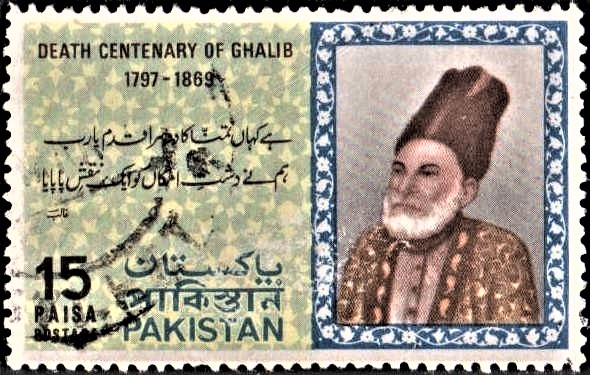
 Issued by Pakistan
Issued by Pakistan
Issued on Feb 15, 1969
Design :
15 Paisa : The stamps is rectangular in format. It is divided into two portions. The right portion consists of Mirza Ghalib’s portrait in a blue frame enriched with Moghul Floral border in reverse. The left portion is a tinted background of rich geometrical pattern of Moghul origin in yellow and green colours containing all the lettering. The words “Death Centenary of Ghalib 1797-1869” appear at the top in black and in the middle the following urdu verse in black :
![]()
Where, O God, does the next step of
Passion lead
The Wilderness of corporeal universe appears
But a foot-print to me.
The denomination figure ‘15’ with ‘Paisa’ and ‘Postage’ underneath appear in black in bottom left corner. The word ‘Pakistan’ in English, Bengali and Urdu appears one above the other at the bottom in blue. The portrait is printed in three colours, orange, black and yellow, the latter colour showing through the embroidery of the dress only. The background of the portrait is grey vignetting off at the top.
50 Paisa : The design of 50 Paisa stamp is the same as of 15 Paisa except that the colour of the frame and the word ‘Pakistan’ in English, Bengali and Urdu appear in purple. The background colour of the left portion is yellow and pink with the following urdu verse in the middle :
![]()
A loftier abode we fain had created
O that for us a residence beyond the stars
Had been destined.
Type : Stamps, Postal Used
Denomination : 15 & 50 Paisa
Colour :
15 Paisa – Peacock Blue, Lemon Yellow, Orange and Black
50 Paisa – Purple, Lemon Yellow, Orange & Black
Size of stamps : 49.2 x 30.6 mm.
Size of Print : 46.2 x 27.6 mm.
Perforation Gauge : 13 x 13(c)
Quantity Printed :
15 Paisa – 15,00,000
50 Paisa – 10,00,000
Number of stamps in each sheet : 50
Process of Printing : Litho Offset
Printers : The Pakistan Security Printing Corporation Ltd., Karachi
Name : Mirza Asadullah Beg Khan
Born on Dec 27, 1797 at Kala Mahal, Agra, Mughal Empire
Died on Feb 15, 1869 at Gali Qasim Jaan, Ballimaran, Chandni Chowk, Delhi, British India [now Ghalib ki Haveli, Delhi, India]
About :
- “Consumed by the agony of remembrance
The remembrance of nights’ festive company
The one remaining candle flickers and dies.”

- So wrote Ghalib, the last and the greatest of classical poets of the Urdu language. The image is characteristic. The flickering candle battling to the last breath, hopelessly and alone, against an inexorable end, may well be the poet himself. He is the last articulate spectator of the glory that has departed – the colour and the gaiety, the warmth and good cheer, the “Saqi of incandescent beauty,” the “songster of the ravishing voice” – and all else that peopled the emptiness of now deserted pleasure halls.
- Thus in two symbolical lines the poet envisions the passing away of an age, a civilisation and a way of life, his own nostalgia for happier times gone by, and an experience, timeless and universal, in the life of all human individuals and human groups – the experience of the evanescence of time.
- The disintegration of the Moghul Empire, began towards the beginning of the 18th century after the death of the Emperor Aurangzeb and culminated in the formal British annexation of the whole sub-continent after the abortive national uprising of 1857. Of the many turbulent epochs in the history of the sub-continent these years were perhaps the most troubled. Following the sack of Delhi in 1739, strife and disorder ravaged the Empire and hordes of marauders scoured the land at will, leaving behind them a disastrous trail of toppled kingdoms, ruined cities and a populace sick with loss and despair. And into this confusion, the foreign invader insinuated himself, first as a trader, then as an ally of one warring faction against another, biding his time until all of them were equally prostrate and after one final convulsion in 1857, the sub-continent resigned itself to the domination of an alien people, to their strange ways, their incomprehensible language and novel values.
- And yet this worst of times was also, in some ways, the best of times. During this period, particularly towards its close, Urdu poetry flowered and attained maturity; there was a significant revival of Muslim learning, and eminent religious reformers sought to rejuvenate the faith by reasserting its moral and social content.

Contact with western civilization and western thought, an introduction to scientific and empirical modes of reasoning, engineered new curiosities and new bewilderments. The rapid erosion of a social edifice, long regarded as fixed and unalterable, demanded new social, cultural and intellectual adjustments. And beyond the ruins of their shattered world, the poet, the scholar, the mystic and the reformer saw the vague glimmer of a world as yet unborn. It was an age of intense pre-occupation with the fundamental problems of life and reality, of heated literacy, theological and philosophical controversies, of doubts and questionings, hopes and fears, sensual abandon and intellectual diligence, of the catharsis of physical suffering through emotional and spiritual expression. - And of the many notable poets of this period, Muhammad Taqi Mir (1723-1810), Muhammad Rafi Sauda (1713-1780), Vali Muhammad Nazir (1735-1830) and Momin Khan Momin (1799-1851), it was Ghalib, above all, who captured, in its entirety, this ‘moment of humanity’, the collective emotional, intellectual and spiritual experience of over a century, and made it timeless. He distilled into his Urdu and Persian verse the pain, the nostalgia and the despair of successive generations who watched in bewildered helplessness their great society drift to its destined doom. At the same time he sought to discover for them through subjective, meditative efforts the why and wherefor, not only of this particular predicament but of the human situation per se and to fortify them with his faith in the eternity of life’s renewal and human regeneration.
- Ghalib wrote both in Urdu and in Persian, both prose and verse, although he is best remembered for the briefest of these writings – his thin volume of Urdu poetry in the traditional ‘ghazal’ form – a rather severely restricted composition of a number of two epigrammatic lines in a uniform metre and rhyme. Even the themes and diction of this form were largely conditioned by popular usage and as the poet had to ‘prove’ himself not in print nut in oral recitation before the audiences of ‘Mushairas’ or poetic assemblies, he generally suited his tune to the demands of popular or country taste. Ghalib for the first time liberated the Ghazal from the tyranny of custom and usage, cut away ornamented frills and conventional trivialities, and in a diction all his own, with a montage of telescoped images and multi-associational meanings, made it into an all-purpose instrument of expression for both personal experience and abstract thought. The bewilderment this aroused at first, soon gave place to comprehension and acceptance and his experiments gave to Urdu poetry completely new dimensions in expression – earnestly thoughtful, deeply truthful, wonderfully plastic and evocative. In diction, methodology of expression, and analytical perception of experience, Ghalib was the first of the moderns in Urdu poetry. For his models Ghalib turned to the great treasure-house of Persian poetry, particularly to the poets of our own sub-continent, Bedil, Urfi, Naziri, thus resorting to Urdu poetry its broken link with this great heritage. He carried this process a step further by making the Persian language his vehicle for the expression of more expansive themes, descriptive, philosophical, discursive or narrative, an example, so eminently followed, later, by Allama Iqbal.
- Ghalib’s contribution to Urdu prose, although perhaps not so deliberate, was equally significant. In his letters, with their wealth of anecdotes, critical observations, pen-portraits, he departed once again from the highly ornate and laboured style of prose-writing common at the time and introduced the language to the rhythm of colloquial speech, to the beauty of the simple word, and a type of sophisticated wit which came spontaneously to his pen.
- “A talisman for the Treasury of Thought
Is the world which finds its way to my verse.” - So Ghalib claimed. And the claim is true of both his prose and his verse.
- Ghalib began his poetic career at the age of about ten and by his middle teens had already become known as something of a literary figure. At the age of twenty four he compiled his first ‘Diwan’ or collection of Urdu poetry. During the next five or six years in the company of the most discriminating scholars and critics of the day gathered in Delhi, he chiselled and perfected his characteristic style and then ventured forth on a new exercise in poetic expression. For nearly twenty years after 1847, in some ways the richest and most arduous years of his life, he wrote mainly in Persian. In 1842-43 he published the first revised version of his Urdu verse and a little later his first collection of Persian poetry. When Ghalib joined the Royal Court in 1850, his indefatigable muse turned to Urdu once again and simultaneously he began pioneering in a completely different field – Urdu prose. It was during this period that he began to correspond with his friends and pupils in Urdu and these inimitable letters were later collected and published in two separate volumes named OOD–I–HINDI (1868) and URDU–I–MUALLA (1869) towards the end of his life. His collection of Persian prose entitled ‘PANJ AHANG’ and a portion of his history of Moghul Kings, a commissioned work called MEHRE NEEMROZE also came out during the same time i.e. 1850-57.
- The period of violent disorder during and after the uprising of 1857, Ghalib spent mostly confined to his house and utilized this enforced leisure to write a diary of his experiences in a Persian pamphlet called DASTAMBO, a picturesque and moving account of those calamitous days. In 1862 he published a polemical pamphlet entitled QATA–I–BURHAN seeking to correct what he considered to be inaccuracies in a Persian Dictionary called BURHAN–I–QATE very popular with Persian scholars of the day, thus re-opening old wounds of his earlier literary skirmishes in Calcutta and in the ensuing uproar, he was called upon to return repeatedly to the fray to answer his many critics.
- During the closing years of is life he saw the publication of his collected works both in Urdu and Persian, never received a penny in royalty, and had to beg and borrow from his friends to buy his own books for distribution to the persons he valued.
- Mirza Asadullah Beg Khan as he was named at birth was born at AKBARABAD (Agra) on 27th December 1797. The non-de-plume which made him famous, he assumed in his twenties when he first turned his pen to Persian verse. In his early Urdu writings the pen-name he used was Asad. Ghalib was descended from a family of Aibak Turks of present day Uzbekistan. His grandfather Mirza Qauqan Beg Khan left his native Samarkand in search of adventure somewhere early in the 18th century and found service with the Moghul Governor of Lahore. Ghalib’s father Mirza Abdullah Beg Khan married into a family of rich noblemen of Agra but this appears to have been the only stroke of good luck he ever had. He was killed in battle in the service of the Prince of Alwar, when Ghalib was only five years old. The orphaned child was given into the care of his uncle Mirza Nasrullah Beg Khan – a man better favoured by fortune. Nasrullah Beg was appointed to the Governorship of Agra by the Marahattas and after the city fell to the British, he was absorbed into the Imperial forces in fairly senior rank. He too died in service four years later. As Nasrullah Beg had no children of his own, the considerable annuity and properties the British had bestowed on him devolved to his collateral heirs, of which Ghalib and his brother Yusuf Beg Khan were the nearest. For Ghalib this proved both a blessing and a bane. While his share of this endowment did ensure for him a subsistence, he was not given what was rightfully his due and until the end of his days he fought an interminable and heart-breaking battle to obtain redress. This hopeless battle with its unending series of defeats, reverses and humiliations, petitions, appeals, an arduous and fruitless journey from Delhi to Calcutta, and knocking at the doors of various British bureaucrats, big and small, is perhaps, the longest shadow which overcast Ghalib’s life, a life beset by many other cares and other sorrows.
- But to return to his childhood. After the death of his uncle Ghalib spent the rest of his early years with his mother’s affluent family at Agra and, from all accounts, these were the happiest and most care-free years of his life. He never completed his formal education, a lack he often regretted, but he did receive instruction in the then popular branches of learning, theology, astronomy, logic, jurisprudence, literature and medicine from a noted local scholar Khalifa Mohammad Muazzam. According to Ghalib’s own avowal, however, his real mentor was a wandering Persian scholar, who spent two whole years with him during his early teens, a Zoroastrian, Hormuzad, by name, who took on the name of Abdus Samad after his conversion to Islam.
- At the age of thirteen, Ghalib was married to Umrao Begum, daughter of Nawab Ilahi Bakhsh Maruf of Delhi. Nawab Ilahi Bakhsh was brother of Nawab Ahmed Bakhsh Khan of Loharu, one of the most influential noblemen of Delhi and a brother-in-law of Ghalib’s uncle Nasrullah Beg. Two or three years after his marriage, Ghalib set up house in Delhi although until he was nineteen or twenty he still spent a good deal of his time in Agra.
- Ghalib’s fame as a poet had preceded him before he settled down in Delhi. He was related by marriage to one of the foremost families of the capital and had a claim to rank among the nobility. Inspite of his haphazard schooling he could hold his own in learned discourse. He was soon accepted as a member of the metropolitan elite, the elite of poets, scholars, and accomplished nobleman, and for the first few years, his life followed the happy and leisurely pattern of the privileged aristocracy, reading, writing, entertaining friends, poetic assemblies, learned discussions, formal calls.
- But the holiday was short-lived. By 1824-25 debts and other financial difficulties he had so blithely ignored began to press heavily upon him and for the next twenty years he was deeply involved in the struggle already referred to, the struggle to retrieve his family pension and other assets. In 1827 he set out for Calcutta to present his case personally to the Governor-General, stopping at Lucknow and Benares on the way. Nothing came of the representation but the journey enriched the poet in many ways. The stay at Benares produced a beautiful long poem in Persian and the sojourn in Calcutta gave him his first intimate glimpse of European society and the new cultural mores they had brought with them. The experiences gave him a new awareness of the progressive march of human social history, confirming his faith in the future of new human societies and in his zest for the joys of living. On the negative side were the heavy and unrecompensed expenses of the journey and of the two years stay in Calcutta.
- At the age of 53, he accepted a job, the incumbent of which technically enjoyed the distinction of being the king’s “poetic tutor”, at the court of the last Moghul King Bahadur Shah. In 1857 came the fearful holocaust after the failure of the nationalist uprising. The victorious British subjected the Muslim populace of Delhi to unspeakable atrocities. Many of Ghalib’s dearest friends were hanged, banished or rendered destitute. His only brother, mentally deranged for some years, died. Ghalib’s meagre pension was discontinued. The fair city he loved was reduced to a waste-land.
- Ghalib survived the calamity for eleven years. To add to all this, Ghalib had his share of personal bereavements. His seven children all died in their infancy. Then he adopted a nephew of his wife whom he dearly loved, Zainul Abedin Arif, and he too died in the prime of youth.
- Such then was the life of this poet. Of his personality and temperament, his friends, pupils and above all his own letters have left us a wealth of material. He was a man of great warmth of heart, a devoted friend, a gracious teacher, as punctilious in his formal duties towards his friends and relatives as he was neglectful of his own interests, as proud of his genius and his station before the world as he was humble towards men he loved and respected. He suffered no fools and was fiercely intolerant of pompous obscurantists and pseudo-scholars. And yet in his personal dealings he was gentle to a fault, even gullible to a degree and a man of great application and industry in his art. But perhaps the dominant and most endearing quality about him was his wit and unfailing good humour, his cheerfulness which kept breaking in on the gloomiest of situations, and a stout resoluteness to see every problem and every situation through.
- This cheerfulness abided by him all through his long and painful sickness until on 15th February, 1869,
“ his flawed heart……
burst smilingly” - “What a free, untrammelled man he was. May God rest his soul”, as he wrote of himself.
- (Write-up contributed by Mr. Faiz Ahmed Faiz)
- Issued by the Director General, Pakistan Post Office, Karachi.




